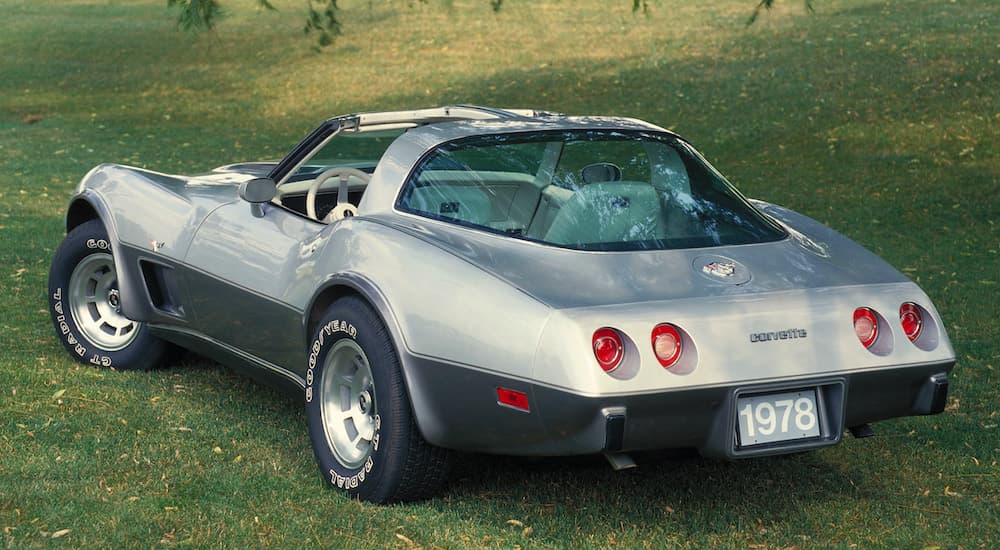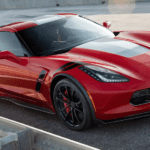A quick trip to your local Chevy dealer, and you’ll find an entire inventory dedicated to popular models like the Tahoe, Suburban, and Silverado. But what if you’re looking for something unique that delivers on your need for speed and adrenaline-packed performance? You’ll have to head inside the dealership, where you’re sure to find the iconic Chevy Corvette sitting on polished floors just begging to be unleashed on the open road.
While the Corvette is one of the best-selling sports cars in the industry, it actually got off to a slow start in the 1950s when it struggled to find its footing––it wasn’t luxurious enough for country club elites, but it didn’t offer enough power to those with a need for speed. The transformation of the Corvette from a mediocre sedan into a sports car took a few years and, eventually, paved the way to the latest addition to the fleet––the stunning and sophisticated 2021 model that boasts a mid-engine layout. To fully appreciate this evolution requires a closer look at the Corvette’s humble beginnings and its rise to fame in America’s vibrant automotive landscape.
The Humble Beginnings of Project Opel
Lackluster automotive sales in the early 1950s prompted automakers like General Motors to design new models that would hopefully attract buyers. For GM, that meant a sports car inspired by those on British roadways. Using the code name “Project Opel,” GM engineers designed a two-seat roadster with a fiberglass body, Chevy’s proven 3.9-liter engine, and a 2-speed automatic transmission that delivered 150 horsepower. With Project Opel, the Corvette was born.
The Corvette made its official debut at GM’s 1953 Motorama and immediately went into production. Offered only in Polo White with a red interior, the Corvette wasn’t the success that GM anticipated, with only 183 models sold. What was the problem? The Corvette didn’t have a niche––it wasn’t luxurious enough for the wealthy, nor was it powerful enough for sports car fanatics. GM attempted to remedy these problems by adding three new paint colors and boosting the engine’s capability to 155 horsepower on the 1954 model. Despite this, Corvette sales failed to impress.

The Corvette Earns Its Stripes
After several failures, Chevy finally gave drivers the power they were looking for by replacing the Corvette’s small engine with the larger and more powerful 4.3-liter V8 that delivered 195 horsepower and was paired with a 3-speed manual transmission. The change was well received and the Corvette finally enjoyed its first wave of success that led to yet another transformation in 1956. This time, Chevy gave the Corvette a distinct sports car design, boosted the engine’s capability to 225 ponies, and added luxury features like external door handles and a power-folding roof. A year later, the Corvette gained even more power with the 283-horsepower V8 that earned the Corvette its legendary sports car status.
The trend continued for the Corvette throughout the 1960s as Chevy made continuous improvements to the powertrain with the engine delivering as much as 560 horsepower (off the record). The Corvette saw the addition of a coupe body style with removable roof panels and improvements to its handling, ride quality, and braking, all of which made it more popular and further distinguished it from its rivals. By the 1970s, federal safety standards and growing emissions restrictions forced Chevy to redesign the front of the Corvette and reduce engine output, which explains the rise and fall of the Corvette’s capability throughout the decade.
Despite the Corvette’s reduction in power, sales continued to soar into the 1980s and 1990s. Chevy’s ongoing improvements to the sports car followed suit and Corvette fans finally saw power return to the sports car. This attracted a new wave of buyers who, by the new millennium, were happy to help the Corvette celebrate its 50th anniversary. Over the next two decades, the Corvette’s capability continued to improve and reached 460 horsepower by 2014, which explains the popularity of the C7 Corvette and its V8 engine. By then, the early Corvette’s luxury features paled in comparison to the digital cockpit, leather seating, and exhaustive suite of connectivity and safety features designed to keep drivers connected, informed, and safe.
Taking the Road Today: 2021 Chevy Corvette
From its humble beginnings to its legendary status, the 2021 Chevy Corvette continues to offer adrenaline-packed performance and loads of adventure. Chevy’s commitment to ongoing innovation is widely apparent throughout the Corvette’s history and is even more so in the latest mid-engine model that reflects the performance and handling of mid-engine supercars. Once again, the Corvette is designed to take your breath away.
The latest Corvette is what Chevy calls a “mid-engine marvel” and delivers an astonishing 495 horsepower and 470 lb-ft of torque courtesy of its 6.2-liter V8 engine and 8-speed dual-clutch transmission with both automatic and manual mode selection. This power translates to exceptional acceleration with a top track speed of 194 mph and a launch from 0 to 60 mph in just 2.9 seconds. The all-new mid-engine layout also means enhanced visibility, better handling, and improved responsiveness, which gives you all the control you need from the driver’s seat.
Along with that control, you’ll enjoy a fully immersive experience from the driver’s seat with the cockpit carefully designed to meet your every need. Those needs start with your comfort with the GT1 package, which is standard on the 1LT and 2LT, wrapping the seats in genuine Mulan leather while the GT2, which is available on the 2LT and is standard on the 3LT, wraps the seats in genuine Napa leather and adds both a seatback halo and carbon-fiber trim. The Competition Sport package is designed with performance in mind and adds aggressive bolsters and high-performance textile to high-wear areas to extend the life of the seats.
With your comfort addressed, Chevy outfits the cockpit with cutting-edge technology that puts all the information and data you need within eyesight or reach. From the driver’s seat, you’ll have a clear view of the 12.0-inch customizable digital instrument display as well as the 8.0-inch center touchscreen display that’s home to the Chevrolet Infotainment 3 system that offers Enhanced Navigation with 3-D View, a variety of in-vehicle apps, Bluetooth capability, a 4G LTE Wi-Fi hotspot, and smartphone integration via wireless Apple CarPlay and Android Auto. The Head-Up Display is a great addition that projects your speed, mileage, fuel level, and other data onto the windshield, while the track-focused Performance Data Recorder serves as a digital driving coach by replaying a high-quality, 1080p recording of your drive with acceleration, braking, gear choice, sound, and more.
Dreams Do Come True
The Corvette’s humble beginnings in the early 1950s make its rise to success even sweeter as the sports car earned its place in the segment and truly proved its legendary status. The 2021 Corvette is a dream that’s been 68 years in the making, with the all-new mid-engine marvel proving the Corvette continues to get better and more powerful with age. You might even call it a living legend.
This remarkable journey means that there’s much more to come for the Chevrolet Corvette Stingray, and that is truly exciting. The Corvette’s evolution is enough proof that Chevy remains committed to one of its best-selling nameplates and to delivering cutting-edge capability, technology, and comfort around every turn. For Chevy, this is what legends are made of.





